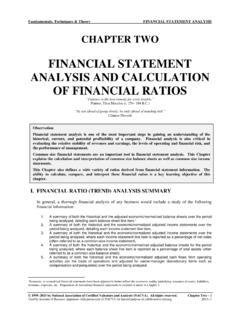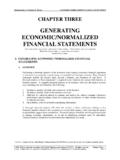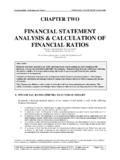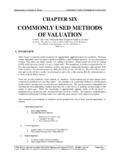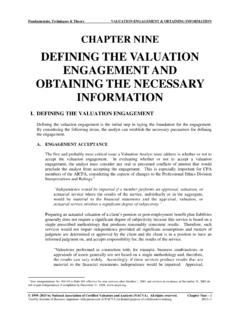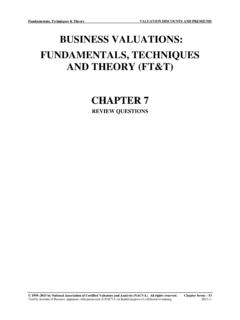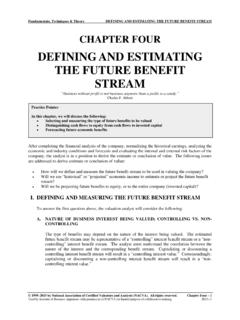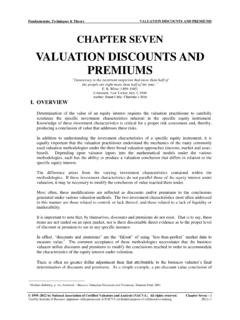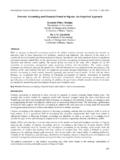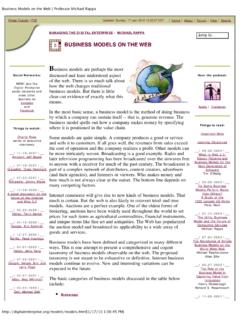Transcription of INTRODUCTION TO BUSINESS VALUATION - NACVA
1 Fundamentals, Techniques & Theory INTRODUCTION TO BUSINESS VALUATION 1995 2015 by National Association of Certified Valuators and Analysts ( NACVA ). All rights reserved. Chapter One 1 Used by Institute of BUSINESS Appraisers with permission of NACVA for limited purpose of collaborative training. CHAPTER ONE INTRODUCTION TO BUSINESS VALUATION Everybody is ignorant, only on different subjects. Will Rogers (1879 1935) American Philosopher, Author I. EVOLUTION OF BUSINESS VALUATION How much is this BUSINESS interest worth? This question is not one that is easily answered. The answer depends on 1) economic factors (these can be local, regional, national, and international); 2) the premise and standard of value selected; 3) appropriate VALUATION method applied; and, 4) interest being valued, to name just a few factors. In this course, all of the above factors are discussed in detail.
2 Historically, the VALUATION of a closely held company was more of an art than a science; there was some guidance provided by the IRS and minimal reporting standards. Accordingly, many in the BUSINESS VALUATION profession served as advocates for the client, rather than as an expert (or advocate for the conclusion of value). The growth and diversity within the VALUATION profession, improvement in software, growing sophistication of the judiciary1 and availability of data through the Internet has transformed the profession and practice. There is now less guesswork and more scrutiny. If the value of a company were determined by a sample of inexperienced or unqualified VALUATION professionals, the distribution of Conclusions of Value (terms defined in NACVA s Professional Standards) can be illustrated by the following bell curve.
3 This bell curve depicts a wide range of values demonstrating VALUATION as more of an art than science: 1 See Daubert et. ux. v. Merrell Dow Pharmaceuticals, Inc., 509 579 (1992) (Court held that the Federal Rules of Evidence, not Frye, provide the standard for admitting expert scientific testimony in a federal trial; nothing in the rules gives any indication that general acceptance is a necessary precondition to the admissibility of scientific evidence. The trial judge has the task of ensuring that an expert s testimony both rests on a reliable foundation and is relevant to the task at hand) and Kumho Tire C. v. Carmichael, 526 137 (1999) (Daubert standard applies to scientific, technical or other specialized knowledge; Rule 702 imposes a special obligation upon the trial judge to ensure testimony is relevant and reliable; reliability assessed by considering if methodology has been tested, subject to peer review, has error rates, and/or is acceptable in the relevant scientific or technical community).
4 A summary of both cases is included in Appendix One. y x Extreme Low Value Extreme High Value INTRODUCTION TO BUSINESS VALUATION Fundamentals, Techniques & Theory 2 Chapter One 1995 2015 by National Association of Certified Valuators and Analysts ( NACVA ). All rights reserved. Used by Institute of BUSINESS Appraisers with permission of NACVA for limited purpose of collaborative training. Observation BUSINESS VALUATION is not for the faint at heart! The distribution of values, obtained from a sample of experienced VALUATION professionals, illustrates two important things: The curve is relatively flat, indicating a broad range of opinions of values The range or spread between the highest and lowest conclusion of value would be relatively large A vast difference in values is considered detrimental to the credibility of professionals involved in BUSINESS VALUATION activities.
5 Consequently, VALUATION analysts must attempt to explain the difference between their different conclusions of value (the term conclusion of value is an important term defined in NACVA s Professional Standard ). One of the primary purposes in this course is to place more emphasis on the science of performing valuations of closely held companies. That said this does not mean the course is intended to teach a prescribed format or preferred methodology. As VALUATION theory and practice evolve, one expects the bell curve to evolve and appear as follows: This illustration reflects a situation where the various conclusions of value are more similar and the range between the highest and lowest value is smaller. NOTE: During the first two or three days of this program you may find studying this topic more than a little frustrating compared to other financial disciplines with which you ve been involved.
6 We urge you to remain patient. As the program is fully laid out you ll begin to see the big picture of the topic. Fundamentals, Techniques & Theory INTRODUCTION TO BUSINESS VALUATION 1995 2015 by National Association of Certified Valuators and Analysts ( NACVA ). All rights reserved. Chapter One 3 Used by Institute of BUSINESS Appraisers with permission of NACVA for limited purpose of collaborative training. II. REGULATORY BODIES BUSINESS VALUATION practice and theory have evolved significantly in the last decade, but many believe this field is still in its relative infancy. VALUATION theory in the areas of intellectual property, venture capital, and limited partnerships is still emerging. A strong theoretical foundation is essential in any field, and the VALUATION professional can look to the following professional and regulatory bodies for guidance.
7 A. INTERNAL REVENUE SERVICE (IRS) 1. Catalyst in the Development of Standards The Internal Revenue Service has substantially contributed to VALUATION theory and is regarded by many as a primary theoretician in the field of VALUATION of closely held businesses. The IRS has issued numerous rulings and pronouncements on this subject, and in 2002 the IRS issued new BUSINESS VALUATION Guidelines, which were updated in 2006 (see Appendix III). Revenue Rulings do not have the force of law, but they do present the position of the IRS on specific tax matters, such as the VALUATION of businesses or equity interests. Beginning in the 1920 s, the IRS published Appeals and Revenue Memorandum 34 (ARM 34, see Appendix III) in response to the Eighteenth Amendment, which enacted Prohibition laws. The purpose of ARM 34 was to establish guidelines and methodologies for determining the amount of loss sustained by a taxpayer as the result of the new laws on Prohibition.
8 Since then, many positions taken by the IRS in Revenue Rulings were rooted in legal disputes. The resolution of these disputes by the courts has established case law precedent. Some of the most important Revenue Rulings (RR) related to BUSINESS valuations are: a) RR 59 60 Valuing Closely held Stock b) RR 68 609 Formula Method c) RR 83 120 VALUATION of Preferred Stock d) RR 93 12 Allowance of Minority Interest Discount in Family Owned BUSINESS Any discussion of VALUATION theory must include an analysis of IRS pronouncements to understand some basic regulatory premises. IRS pronouncements began with the issuance of ARM 34 in 1920 and continue to the present day. Observation The Internal Revenue Service (IRS) was and remains an important body in the development and transformation of VALUATION theory.
9 Rev. Ruling 59- 60 is among the most important and often cited revenue rulings; participants are urged to read and understand this revenue ruling. In this section the evolution of BUSINESS VALUATION theory, as developed in various Revenue Rulings, is introduced. INTRODUCTION TO BUSINESS VALUATION Fundamentals, Techniques & Theory 4 Chapter One 1995 2015 by National Association of Certified Valuators and Analysts ( NACVA ). All rights reserved. Used by Institute of BUSINESS Appraisers with permission of NACVA for limited purpose of collaborative training. IRS pronouncements are discussed in the following text as they relate to BUSINESS VALUATION theory. It is extremely important for the VALUATION analyst to become knowledgeable of the relevant issues in these pronouncements. It is highly recommended that you take the time to study these pronouncements carefully (copies of the following IRS pronouncements are provided in Appendix III of this manual).
10 A) 1920 ARM 34 (See Appendix III) (1) Issued in 1920 (2) Resulted from the enactment of Prohibition (3) Issued as the result of the enactment of Prohibition, to assist taxpayers in determining the amount of intangible value lost by businesses previously involved in the alcoholic beverage industry Methods prior to ARM 34 Very few owners of businesses understood that their businesses might have had intangible value; therefore, many businesses were sold and transferred at tangible asset values only. ARM 34 introduced two key concepts: (1) Goodwill exists if a BUSINESS has excess earnings (2) Goodwill value is determined by capitalizing the excess earnings ARM 34 also introduced two key problems: (1) What are excess earnings? ARM 34 says that excess earnings are the earnings of the company in excess of earnings above the norm of companies with similar activities and size.
